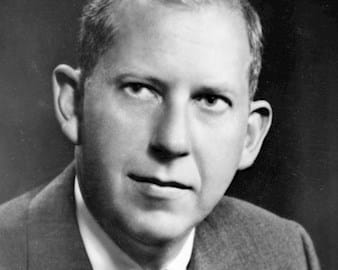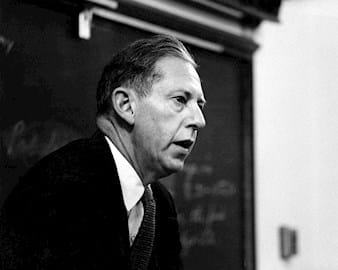
1931
Graduated from the University of Washington with a BA
1931
One of the great economists of the 20th century, the late George J. Stigler played a key role in establishing Chicago Booth as a world leader in economics research.
Born in 1911 and raised near Seattle, Stigler came to the University of Chicago in 1933 to pursue a PhD in economics. At the University of Chicago, he found an intellectual home and forged lifelong friendships with classmates W. Allen Wallis and Milton Friedman, the 1976 Nobel Prize winner in Economic Sciences.
“The Chicago Economics Department was in intellectual ferment, although the central issues of the 1930s were very different from those in later times,” Stigler later wrote. “I had never before encountered minds of that quality at close quarters, and they influenced me strongly.”
He went on to teach at Iowa State College, the University of Minnesota, Brown University, and Columbia University before joining the faculty at the University of Chicago, where he remained for the rest of his career.
Much of Stigler’s pioneering work focused on government regulation, market competition, and the price system, particularly the impact of public policy on competition and monopolies.
In 1962, his groundbreaking article “What Can Regulators Regulate? The Case of Electricity” upended the notion that government regulation was effective at correcting private-market failures by showing that government regulation had little effect on lowering prices in monopolies.
In 1971, he introduced the idea of regulatory capture, which says that regulators can be dominated by special interests and work for the benefit of large, monied organizations rather than the public good. Stigler’s work forced economists to consider regulation with empirical analysis, much as they studied other economic questions.
In addition to being recognized for his groundbreaking research, Stigler was known for his sharp wit and wrote several tongue-in-cheek essays poking fun at the field of economics. For example, “The Conference Handbook,” a 1977 article in the Journal of Political Economy, proposed a list of numbered objections that could be offered during discussions of research papers to save time. (No. 1: “Adam Smith said that.”)
In 1977, Stigler founded the Center for the Study of the Economy and the State, dedicated to understanding issues at the intersection of politics and the economy. Following his death in 1991, the center was renamed the George J. Stigler Center for the Study of the Economy and the State in his honor.

“I am not a Reagonomics man. I’m not a supply-sider. But reducing unnecessary government burdens on production is a wonderful thing.”
—George J. Stigler
Stigler’s Nobel Prize–winning work “opened up a completely new area of economic research,” as the Nobel Committee put it. His pioneering research at the intersection of economics and law changed the way economists think about government regulation and competition.
Archival images courtesy of the Hanna Holborn Gray Special Collections Research Center, University of Chicago Library.